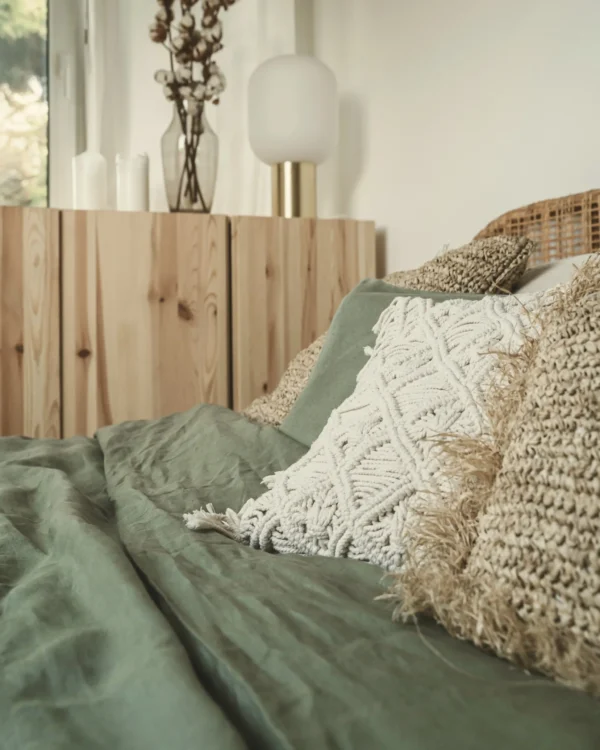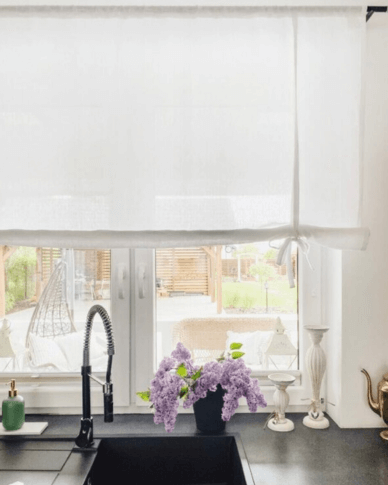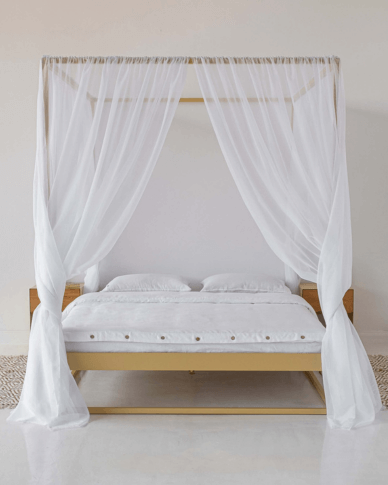Advice, Flax
Linen is the perfect material for all year round – not just summer
- Data publikacji:
Table of contents
Do you associate linen only with summer dresses and airy bed linen? This is the biggest mistake in thinking about this remarkable material! Linen is an ideal year-round material, which, thanks to its unique properties, works equally well in winter and summer. Its natural thermoregulatory abilities, durability and wearing comfort make it deserve a place in your closet 365 days a year. In this article, you'll discover why you should invest in linen clothing regardless of the season and how to maximize its potential.
Get ready to change your outlook on linen - from now on you will see it as the most versatile material in your closet!
Linen's thermoregulatory properties - the science behind comfort
Linen has unique thermoregulatory properties that make it comfortable in all weather conditions. Linen fibers have a natural ability to regulate body temperature due to their unique structure. On hot days, linen wicks away excess heat and moisture, while in cooler periods it provides a pleasant warming by creating an insulating layer of air.
The structure of linen fibers consists of natural channels that allow air to circulate freely. This is why linen "breathes" better than most synthetic materials. Scientific research confirms that linen fabrics can absorb up to 20% of their weight in the form of moisture, without losing the dry feeling on the skin.
In addition, the thermal conductivity of linen is much higher than that of cotton or synthetics. This means that the material quickly adapts to the temperature of the environment and the body, providing optimal thermal comfort. These properties make linen suitable both as a base layer in winter and as the main clothing material in summer.
Comparison with other materials
Compared to cotton, linen has 3 times better breathability and 50% more moisture absorption capacity. Synthetic fabrics, although often advertised as breathable, do not match the natural temperature-regulating properties that linen offers.
Flax research
Research conducted by the Textile Institute confirms that linen stabilizes skin temperature within 2-3 degrees Celsius, regardless of external conditions. This makes it an ideal material for people sensitive to temperature changes.
Airiness of linen in different seasons
Linen's breathability is its second most important characteristic after thermoregulation. The natural structure of linen fibers creates microscopic air channels that allow free ventilation. Contrary to popular belief, this property does not mean that linen is suitable only for summer - on the contrary, it makes it versatile.
In summer, the breathability of linen provides natural air conditioning for the body. Hot air is drawn away from the skin, and fresh air flows in its place. Linen is called "natural air conditioning" for a reason - its cooling properties are legendary in countries with hot climates.
In autumn and winter, the same breathability acts as a ventilation system that prevents the body from overheating during physical activity or in heated rooms. Linen allows the skin to breathe, which is especially important when wearing several layers of clothing. This avoids the unpleasant feeling of stuffiness and sweating.
Practical application of airiness
Sportswear made of linen is gaining popularity precisely because of its breathability. Linen shirts are perfect for yoga, Pilates or light cardio workouts in any season.
Linen vs. synthetic fabrics
While synthetics often trap moisture and restrict air circulation, linen naturally ventilates the body without the use of chemical additives or special technical finishes.
How flax behaves in winter - dispelling myths
One of the biggest myths about linen is that it is a summer-only material. Linen can be just as comfortable in winter as it is in summer if used properly. The key is to understand how linen works with other layers of clothing in a layering system.
Linen as a base layer in winter styling works great. Its moisture-absorbing properties keep the skin dry even during intense physical activity. In addition, linen does not accumulate static electricity, which is a common problem with synthetic materials in winter.
In colder weather, linen can serve as a middle layer when paired with a wool sweater or jacket. Its breathability prevents overheating, while outer layers provide thermal insulation. Many people discover that a linen shirt under a sweater is much more comfortable than a cotton alternative.
Linen bedding and home textiles all year round
Linen bedding is a real treasure for anyone who values sleeping comfort regardless of the season. Linen's thermoregulatory properties mean that a bedding set made of this material ensures optimal body temperature during both summer heat and winter nights. Linen naturally wicks away moisture and prevents the body from overheating during sleep.
Linen sheets are especially appreciated by people who sweat frequently or live in climates with wide temperature fluctuations. The structure of linen fibers creates natural ventilation that keeps the bed fresh and dry throughout the night. Unlike synthetic bedding, linen does not accumulate static electricity or unpleasant odors.
Linen bedspreads and blankets work well as decorative items that also serve a practical function. In the winter they can serve as an extra layer of warmth, and in the summer as a light covering during an afternoon's rest. Their natural, slightly wrinkled appearance adds coziness and elegance to interiors.
Advantages of linen home textiles
- Linen sheets and pillows - ensure optimal ventilation of the head during sleep
- Linen curtains - Filter the light and regulate the temperature in the room
- Linen towels - dry quickly and stay fresh longer than cotton ones
Hygiene and sleep comfort
Linen has natural antibacterial properties, making it the ideal bedding material for people with sensitive skin or allergies. Studies confirm that one sleeps on average 15% more soundly in linen bedding.
Linen in all-season clothing - versatile applications
Linen in the winter closet is the art of combining natural materials into harmonious wholes. You will achieve the best results by combining linen with wool or cashmere - materials that complement each other's properties. Linen provides ventilation and comfort, while wool provides warmth and insulation.
Linen shirt is a true classic that works all year round. In summer it is worn solo, in autumn and winter under sweaters or jackets. Its versatility lies in its ability to create both elegant and casual styles. Linen only gets softer and more pleasant to wear with time.
Styling with linen can be created in layering - linen as a base layer works well with other natural materials. This versatility means that investing in a few key linen pieces can completely transform your closet.
Comparison of linen with other all-season materials
Flax vs. cotton - is the comparison that most often comes up in the context of year-round fabrics. Cotton, while popular and versatile, cannot compete with linen in terms of thermoregulation. Linen dries faster, wicks away moisture better and is more durable. At the same time, linen gets softer over time, while cotton can lose its elasticity.
Linen versus wool is a juxtaposition of two natural giants. Wool is great in winter due to its insulating properties, but in summer it can be too warm. Linen is more versatile - in winter as a base layer, in summer as the main clothing material. In addition, linen is easier to care for and less prone to mending.
Synthetics vs. linen is a comparison of modernity with tradition. Synthetic materials often have special technical properties, but linen offers natural comfort without the need for chemical treatment. While synthetics can cause allergies or odors, linen has natural antibacterial properties.
Comparative table of properties
| Property | Linen | Cotton | Wool | Synthetics |
|---|---|---|---|---|
| Thermoregulation | ★★★★★ | ★★★ | ★★★★ | ★★ |
| Ventilation | ★★★★★ | ★★★ | ★★ | ★★★ |
| Persistence | ★★★★★ | ★★★ | ★★★★ | ★★ |
| Ease of care | ★★★ | ★★★★ | ★★ | ★★★★★ |
Flax as a long-term investment
Quality linen can last for decades, making it a more economical option than cheaper alternatives that require frequent replacement.
Flax care all year round
Linen care is not at all as demanding as it might seem. The most important rule is regular washing at low temperatures (30-40°C) and natural detergents. Linen likes water - the more often you wash it, the softer and more pleasant to the touch it becomes. This property distinguishes it from many other materials.
Flax drying is best done in the air, avoiding direct sunlight, which can weaken the fibers. Linen dries quickly due to its airiness, so even in winter it is not much of a problem. If you must use a dryer, choose a low temperature and take out the clothes slightly damp.
Do your linen ironing while the fabric is still slightly damp. Linen tolerates high temperatures, so you can use the steam function. Remember that light creases are the natural charm of this material - you don't have to strive for perfect smoothness. Many people appreciate linen precisely for its slightly nonchalant look.
Summary
Indeed, linen is an ideal year-round fabric that works well in all seasons thanks to its unique thermoregulatory and breathable properties. Its ability to regulate body temperature, natural durability and wearing comfort make it an investment that will pay off over years of use. Whether you're looking for lightweight clothing for summer or comfortable base layers for winter, linen offers solutions to fit your needs. It's time to abandon thinking of linen as a seasonal material and discover its full potential.
Start building your year-round linen collection today - your skin, sleep and home comfort will thank you!
Related blog articles











